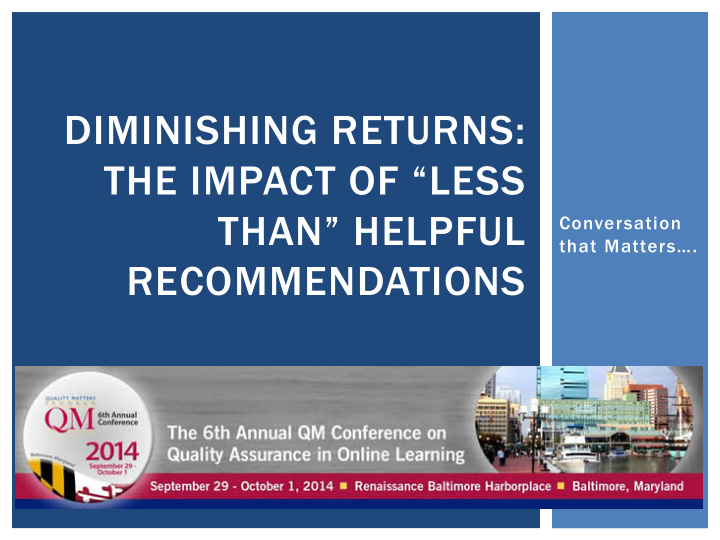



DIMINISHING RETURNS: THE IMPACT OF “LESS THAN” HELPFUL Conversation that Matters…. RECOMMENDATIONS
PRESENTERS Elizabeth McMahon • Minnesota Online Quality Initiative/ Northland Community & Technical College • Statewide Lead QM Coordinator • @bethmcmahon @mnquality Linda Jacoby • Minnesota State University, Mankato (Retired) • Former Statewide Lead QM Coordinator This work is licensed under a Creative Commons Attribution-NonCommercial-ShareAlike 4.0 International License.
AGENDA Purpose & Structure of “Helpful” Recommendations Identifying “Less Than” Helpful Recommendations Discussion: Impacts & Strategies For Improvement
QM AFFILIATE INSTITUTIONS IN MINNESOTA
HELPFUL RECOMMENDATIONS The review team’s recommendations are key to the success of a review. Recommendations let the instructor know how to improve the course so they will receive the "meets expectation" rating.
Sample ???
Sample ???
“LESS THAN” HELPFUL TYPES . Too Little Misguided Prescriptive Checklist Copy/Paste Too Much
“LESS THAN” HELPFUL EXAMPLES on and student engagement highlight Standard 5.2. As best practice, QM recommends online instructors to offer rich opportunities to engage with course content, the instructor, and with each other. As suggested above, rich on implies that students actively engage in the course and create knowledge for themselves (learning by doing or by y). se offers a large amount of content but no graded discussions (except for boosting grades to the next highest level hin 1% of a better grade). In the Getting Started document, “Using the MyIMS Discussion Forum,” students are o pose or answer questions in Question & Answer forums created for each chapter. These forums are driven by students, with limited instructor involvement, except for when students “lead one another into the ditch.” That mpowers learners with a sense of community and responsibility, but the exclusive emphasis on question and may unfairly award only those students bright enough to share an answer or bold enough to admit their lack of Types of interaction include student- nding. & Answer forums can greatly benefit students, especially if students monitor (or better yet, subscribe to) the forum instructor, student-content, and student- n from one another. That’s great, but you could enhance interactivity further with some of the QM-recommended , such as webquests, student presentations, collaborative or group projects (labs), or peer critiques of assigned student. Active learning involves sets. students engaging by "doing" udents have frequent opportunities to read and reflect, there are far fewer activities that require self-initiative or on. Requiring at least one or two student presentations, with peer assessment, is one strategy for empowering something, such as discovering, with a sense of responsibility and ownership of learning outcomes. Students might also “step up their game” that peers will review their work. processing or applying concepts and k from the instructor is presumably designed into the course in the form of comments from weekly exams and in scussions. Unfortunately, QM reviewers do not have access to emails or gradebook comments, so there is no way to information. Active learning implies he richness of constructive feedback. The disadvantage of assessments based primarily on objective exams choice, true-false and short answer) is that there is little opportunity for one-on-one instructor engagement. guiding students to increasing levels of e is felt indirectly and almost exclusively in videos, announcements and instructions. responsibility for their own learning. large class, however, the lack of personal attention is understandable and in no way detracts from the quality of se. Still, it would be a great improvement if there were at least 1-2 class activities that allowed students to interact Excellent sonally with the instructor. As one possible alternative, the instructor could host a live (synchronous) orientation at nning of the class, in which students can ask questions about the many Getting Started documents and guidance, ibly another live session shortly before the final exam to ask questions in real time. ng whether the standard is met, this reviewer had much difficulty. Undoubtedly, the publisher materials afford an ve amount of student-content interaction. But there is little student-student and even less student-instructor on (unless feedback is found exclusively in emails, discussions or the gradebook, which reviewers cannot view to t d t i ) J d i l l b t i t d i t t li it d t G tti St t d
IMPACT
DIMINISHING RETURNS Impact on Institution Impact on Reviewers Impact on Course Representative Impact on QM
SUGGESTED STRATEGIES Master Reviewer/ Team Chair Reviewers Quality Matters
LET’S CONTINUE THE CONVERSATION…. For further discussion or to receive a copy of the strategies listed today, email me @ elizabeth.mcmahon@northlandcollege.edu http://minnesota.qualitymatters.org
Recommend
More recommend